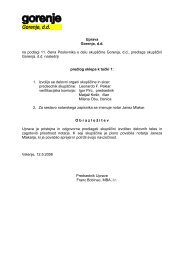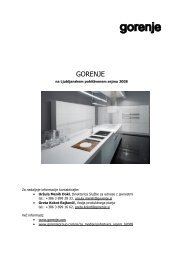ANNUAL REPORT 2008 - Gorenje Group
ANNUAL REPORT 2008 - Gorenje Group
ANNUAL REPORT 2008 - Gorenje Group
You also want an ePaper? Increase the reach of your titles
YUMPU automatically turns print PDFs into web optimized ePapers that Google loves.
148<br />
<strong>2008</strong><br />
in the estimates used to determine the recoverable amount. An impairment loss is reversed only to<br />
the extent that the asset’s carrying amount does not exceed the carrying amount that would have<br />
been determined, net of depreciation or amortisation, if no impairment loss had been recognised.<br />
(j) Employee benefits<br />
Short-term benefits<br />
Short-term employee benefit obligations are measured on an undiscounted basis and are expensed<br />
as the related service is provided.<br />
(k) Provisions<br />
A provision is recognised if, as a result of a past event, the Company has a present legal or constructive<br />
obligation that can be estimated reliably, and it is probable that an outflow of economic benefits<br />
will be required to settle the obligation. Provisions are determined by discounting the expected<br />
future cash flows at a pre-tax rate that reflects current market assessments of the time value of<br />
money and the risks specific to the liability.<br />
(i) Warranties<br />
A provision for warranties is recognised when the underlying products or services are sold. The<br />
provision is based on historical warranty data and a weighting of all possible outcomes against their<br />
associated probabilities.<br />
(ii) Site restoration<br />
In accordance with the Company’s published environmental policy and applicable legal requirements,<br />
a provision for site restoration in respect of contaminated land, and the related expense, is<br />
recognised when the land is contaminated.<br />
(iii) Onerous contracts<br />
A provision for onerous contracts is recognised when the expected benefits to be derived by the<br />
Company from a contract are lower than the unavoidable cost of meeting its obligations under the<br />
contract. The provision is measured at the present value of the lower of the expected cost of terminating<br />
the contract and the expected net cost of continuing with the contract. Before a provision is<br />
established, the Company recognises any impairment loss on the assets associated with that contract.<br />
(iv) Provisions for retirement bonuses and jubilee benefits<br />
In accordance with the statutory requirements, the collective agreement, and the internal regulations,<br />
the Company is to pay to its employees jubilee benefits and termination benefit upon retirement.<br />
For these obligations, long-term provisions are created.<br />
Provisions are determined by discounting, at the balance sheet date, the estimated future benefits<br />
in respect of retirement bonuses and jubilee benefits. The obligation is calculated separately<br />
for each employee by estimating the costs of retirement bonus and the costs of all expected jubilee<br />
benefits until retirement. The selected discount rate is 7.75% p.a. and represents the rate of return<br />
on long-term government bonds. The calculation is performed by a certified actuary using the<br />
projected unit method.<br />
( l ) R e v e n u e<br />
(i) Revenue from the sale of products<br />
Revenue from the sale of products, merchandise and materials is measured at the fair value of the<br />
consideration received or receivable, net of returns and allowances, trade discounts and volume re-

















